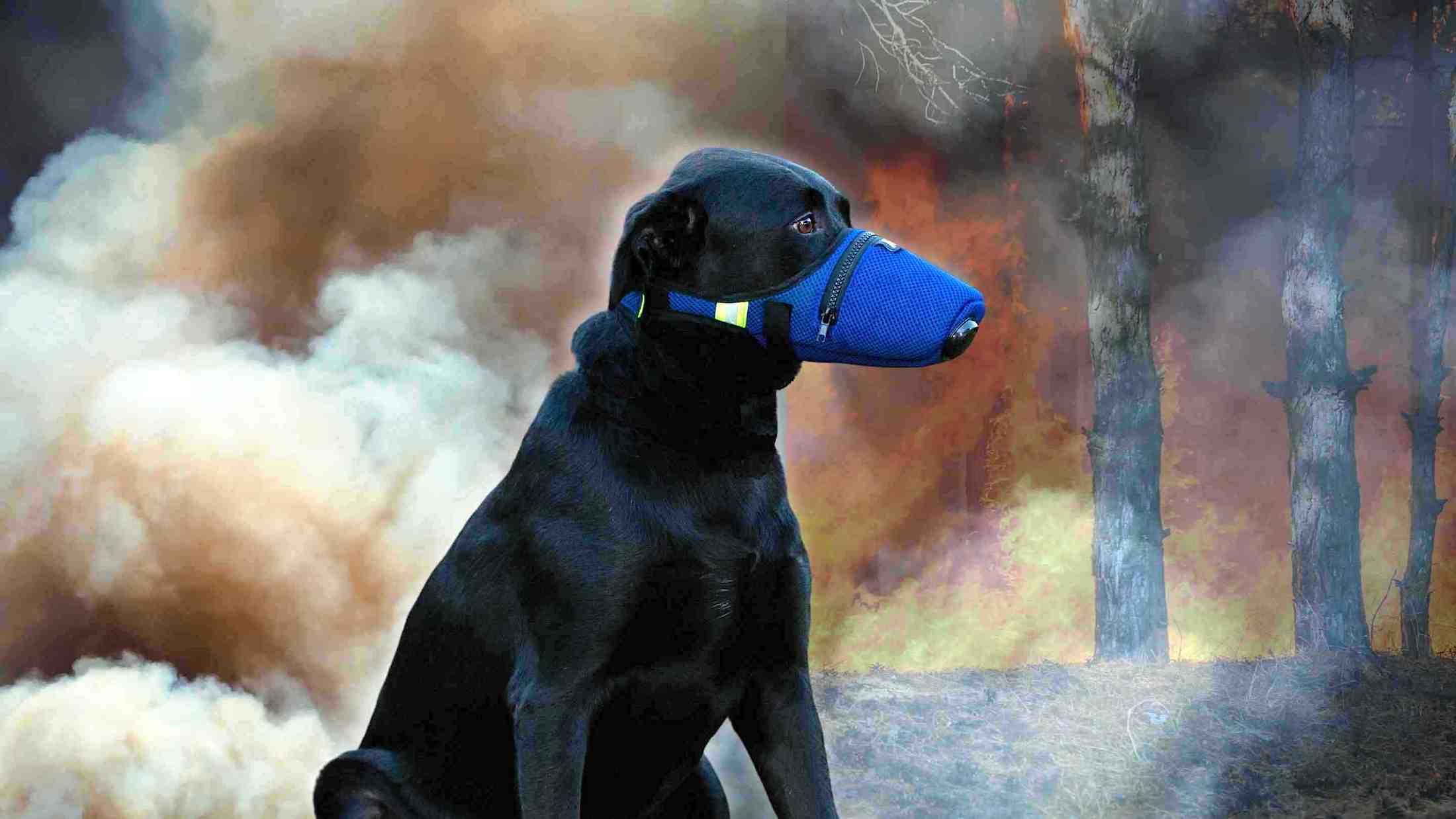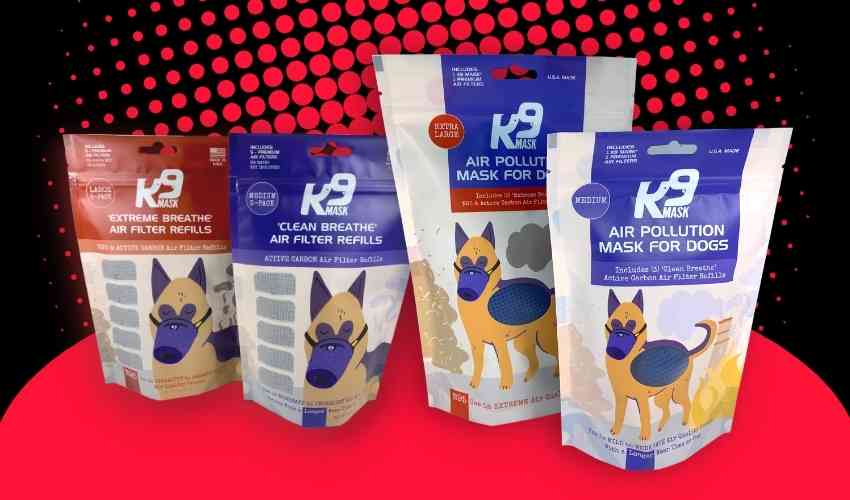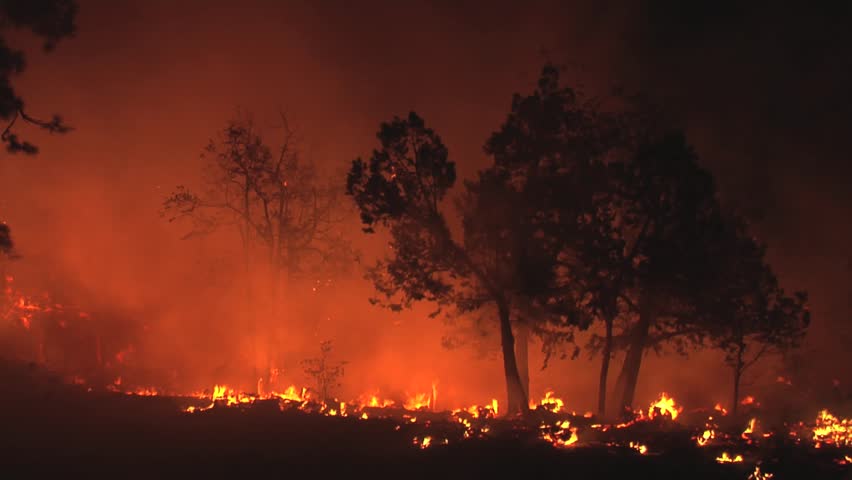Smoke inhalation is not only dangerous for people - it can also have very serious consequences for dogs. Across parts of California including areas not in the path of the wild fires, air quality is being ranked as some of the worst in the world. As firefighters battle the wild fires animal welfare groups are working around the clock to rescue dogs.
Smoke Inhalation in Dogs
Dr. Tina Wismer the Medical Director of the ASPCA Animal Poison Control Center explains that, “With smoke inhalation, the amount of smoke a dog is exposed to will affect the symptoms. Animals that are caught in a fire can have difficulty breathing, inflammation and burns in the airways, and weakness. In some cases, dogs may initially appear normal and then develop a buildup of fluid in the lungs (pulmonary edema) up to 24 hours later.”
 She further explains that dogs living near wildfires and breathing smoke may also experience eye irritation. Your dog may experience watery or red eyes, coughing, runny noses and panting if exposed to wildfire smoke. Dr. Heather B. Loenser, DVM Senior Veterinary Officer of the American Animal Hospital Association, also encourages dog guardians in smoke impacted areas to be on the lookout for the following symptoms:
She further explains that dogs living near wildfires and breathing smoke may also experience eye irritation. Your dog may experience watery or red eyes, coughing, runny noses and panting if exposed to wildfire smoke. Dr. Heather B. Loenser, DVM Senior Veterinary Officer of the American Animal Hospital Association, also encourages dog guardians in smoke impacted areas to be on the lookout for the following symptoms:
- Rapid respiratory rate (breathing more than 20-30 breaths per minute a rest)
- Coughing; strained or noisy breathing
- Bright red gums
- Lethargy, seizures.
Impact of Long-Term Smoke Inhalation in Dogs
Although some symptoms of smoke inhalation are visible right away, dogs who have been exposed to smoke may get sick some time after the exposure. Jordan Holliday from Embrace Pet Insurance explains that, “once your pet has been rescued from a fire, he or she may appear pretty normal. Unfortunately, initial appearances can be deceiving. Even if your dogs didn’t come into contact with fire and get burned, they may have severe internal issues that need to be addressed."
Holliday cautions, “The most common cause of fire-related deaths in pets is not skin damage from burns, but organ damage from carbon monoxide toxicity. During a fire, carbon monoxide replaces the oxygen in the air. When a pet breathes carbon monoxide instead of oxygen, his organs will not be able to function correctly.” This is why it’s so important any dogs being rescued from wild fire impacted areas are seen by veterinarians.
How To Minimize the Risk: Smoke Exposure for Dogs
The most important thing you can do if your dog has been exposed to smoke is to get them out of the situation as soon as possible. If your dog has any of the above symptoms of smoke toxicity, Dr. Loenser advises you to get your dog seen by a veterinarian to receive oxygen therapy. Dr. Loesner explains that veterinary hospitals have oxygen cages that allow (all but the largest) dogs to rest in an oxygen-rich environment.
 Giant dogs that are too large for the oxygen cages can be provided oxygen therapy through a nasal cannula with allows oxygen to flow into a dog’s nose. “Treating a dog with oxygen is one of my favorite treatments because I love seeing the look of relief when they realize they can breathe easier,” says Dr. Loesner. Here is a video example of a dog receiving oxygen therapy from the Castlegar Fire Department in British Columbia, Canada. animal medical center ny oxygen therapy. Dogs being rescued by first responders are increasingly being treated with oxygen therapy on the scene, but Dr. Loenser advises that any dogs rescued from wildfires or any other fire should be directed to a veterinarian within an hour of being rescued.
Giant dogs that are too large for the oxygen cages can be provided oxygen therapy through a nasal cannula with allows oxygen to flow into a dog’s nose. “Treating a dog with oxygen is one of my favorite treatments because I love seeing the look of relief when they realize they can breathe easier,” says Dr. Loesner. Here is a video example of a dog receiving oxygen therapy from the Castlegar Fire Department in British Columbia, Canada. animal medical center ny oxygen therapy. Dogs being rescued by first responders are increasingly being treated with oxygen therapy on the scene, but Dr. Loenser advises that any dogs rescued from wildfires or any other fire should be directed to a veterinarian within an hour of being rescued.
Caring For Dogs in Poor Air Quality Conditions
If you are living in an area where air quality conditions are poor, the best thing you can do is to keep your dog inside as much as possible. Limiting the length and frequency of walks and staying out of outdoor spaces like dog parks is advised until air quality improves. Trick training or Scent Work games are a great way to keep your dog mentally and physically exercised in your house or apartment. Humans in areas impacted by wildfires are being encouraged to wear face masks or respirators to minimize the risks associated with breathing smoke. There are a few different masks on the market for dogs such as Dog Pollution Mask, and goggles like these from Doggles that may reduce eye irritation from the smoke. Unfortunately, unlike masks for people these masks are less readily available.
 Having just moved with my dogs from New York to Oregon (which in recent years has had more issues with wildfires like neighboring Northern California), I am considering buying air pollution masks for my dogs. Don't do this after a wildfire in your area. Of course, this means once I have the K9 dog pollution masks, I’ll need to begin slowly desensitizing my dogs to wearing them. If an air quality emergency were to occur, my dogs need to already comfortable with wearing and breathing through something on their faces – a sensation that might feel strange to anyone.
Having just moved with my dogs from New York to Oregon (which in recent years has had more issues with wildfires like neighboring Northern California), I am considering buying air pollution masks for my dogs. Don't do this after a wildfire in your area. Of course, this means once I have the K9 dog pollution masks, I’ll need to begin slowly desensitizing my dogs to wearing them. If an air quality emergency were to occur, my dogs need to already comfortable with wearing and breathing through something on their faces – a sensation that might feel strange to anyone.
Which Dogs Are at Risk for Complications from Smoke Exposure
Smoke inhalation is dangerous for all dogs regardless of breed or age, but there are specific concerns with some breeds. Dr. Loenser explains that dogs with short noses - bulldogs, pugs and Boston terriers, to name a few - are especially at risk. Additionally, Loesner explains that very young and very old dogs of any breed can be more fragile and at risk for medical complications from smoke inhalation.
Being Prepared
The wildfires in California are a good reminder about the importance of having an evacuation plan for your family including all your dogs. Natural disasters can strike at any time and it’s important to be prepared. Make sure your dog is wearing a collar with updated identification tags. In your vehicle it’s a good idea to have easily accessible digital copies of proof of vaccination, photos of your dog (in case they become lost), spare leashes, food, and any prescriptions your dog might need.
Jordan Holliday advises to, when developing an evacuation plan, have a designated person in your household responsible for evacuating the dog. If no one is able to get your dog(s) out, this person needs to, “let the fire department personnel know that he or she is still inside the home. Have your pet microchipped so that in the event your pet is able to escape, you can find him or her after the fire. Place a sticker or identification in the window of your home so that fire department personnel know there is a pet in the home if a fire breaks out when you aren’t there.”













